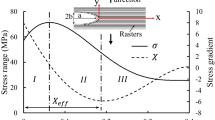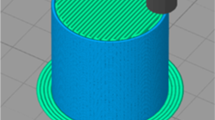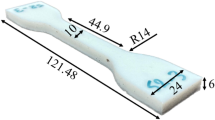Abstract
In the search to understand the functional capabilities and limitations of fused deposition modelling (FDM) manufactured components, control over their structural behaviour is crucial. For example, voids introduced during the production phase are a large contributor to anisotropy, yet the magnitude of this contribution remains unquantified. As a baseline model for quantifying strength reduction due to process-induced voids, a statistical method for evaluation of the minimum residual (net) cross section is proposed and tested. Our new method serves to predict the reduction in ultimate tensile strength of transversely printed specimens relative to solid or longitudinally printed specimens, based on void sizes identified from microscopy images of the centre plane of a tensile specimen. ImageJ is used to identify void sizes from the microscopy images, and residual cross sections are determined using a bit counting MATLAB script. From the distribution of residual cross sections, the weakest link for a given sample size is estimated. The accuracy of the proposed method is determined through comparison with experimental test data for samples of polylactic acid (PLA). The results reveal a close yet slightly under-predicted strength estimate, which for the case considered predicted approximately 5 MPa (12%) lower strength than observed in the experiments. Based on our findings, we have established evidence that the anisotropic behaviour of FDM specimens in PLA can to a large extent be explained by the reduction in residual cross section. This implies that other effects such as fracture mechanics and atomic diffusion of polymer chains play a secondary role for the phenomena observed.
Article PDF
Similar content being viewed by others
Avoid common mistakes on your manuscript.
References
Tronvoll SA, Elverum CW, Welo T (2017) Prototype experiments: strategies and trade-offs. Procedia CIRP 60:554–559
Wohlers T. (2016) Wohlers report 2016. Wohlers Associates, Inc.
Chen L, He Y, Yang Y, Niu S, Ren H (2017) The research status and development trend of additive manufacturing technology. Int J Adv Manuf Technol 89:3651–3660
Ahn S, Montero M, Odell D, Roundy S, Wright PK (2002) Anisotropic material properties of fused deposition modeling ABS. Rapid Prototyp J 8:248–257
Ahn SH, Baek C, Lee S, Ahn IS (2003) Anisotropic tensile failure model of rapid prototyping parts—fused deposition modeling (FDM). Int J Mod Phys B 17:1510–1516
Rodríguez JF, Thomas JP, Renaud JE (2001) Mechanical behavior of acrylonitrile butadiene styrene (ABS) fused deposition materials. Experimental investigation. Rapid Prototyp J 7:148–158
Rodriguez JF, Thomas JP, Renaud JE (2000) Characterization of the mesostructure of fused-deposition acrylonitrile-butadiene-styrene materials. Rapid Prototyp J 6:175–186
Torres J, Cotelo J, Karl J, Gordon AP (2015) Mechanical property optimization of FDM PLA in shear with multiple objectives. JOM 67:1183–1193
Torres J, Cole M, Owji A, DeMastry Z, Gordon AP (2016) An approach for mechanical property optimization of fused deposition modeling with polylactic acid via design of experiments. Rapid Prototyp J 22:387–404
Sood AK, Chaturvedi V, Datta S, Mahapatra SS (2011) Optimization of process parameters in fused deposition modeling using weighted principal component analysis. J Adv Manuf Syst 10:241–259
Casavola C, Cazzato A, Moramarco V, Pappalettere C. Materials & design 2016;90:453–458
Mahmood S, Qureshi AJ, Goh KL, Talamona D (2017) Tensile strength of partially filled FFF printed parts: experimental results. Rapid Prototyp J 23:122–128
Sun Q, Rizvi GM, Bellehumeur CT, Gu P (2008) Effect of processing conditions on the bonding quality of FDM polymer filaments. Rapid Prototyp J 14:72–80
Chacón JM, Caminero MA, García-Plaza E, Núñez PJ (2017) Additive manufacturing of PLA structures using fused deposition modelling: effect of process parameters on mechanical properties and their optimal selection. Mater Des 124:143–157
Liu X, Zhang M, Li S, Si L, Peng J, Hu Y (2017) Mechanical property parametric appraisal of fused deposition modeling parts based on the gray Taguchi method. Int J Adv Manuf Technol 89:2387–2397
Thrimurthulu K, Pandey PM, Venkata Reddy N (2004) Optimum part deposition orientation in fused deposition modeling. Int J Mach Tools Manuf 44:585–594
Panda SK, Padhee S, Sood AK, Mahapatra SS (2009) Optimization of fused deposition modelling (FDM) process parameters using bacterial foraging technique. Intell Inf Manag 01:89–97
Letcher T, Waytashek M (2014) Material property testing of 3D-printed specimen in PLA on an entry-level 3D printer, ASME 2014; IMECE2014–39379
Song Y, Li Y, Song W, Yee K, Lee K-Y, Tagarielli VL (2017) Measurements of the mechanical response of unidirectional 3D-printed PLA. Mater Des 123:154–164
Bellehumeur C, Li L, Sun Q, Gu P (2004) Modeling of bond formation between polymer filaments in the fused deposition modeling process. J Manuf Process 6:170–178
Li L, Sun Q, Bellehumeur C, Gu P (2002) Composite modeling and analysis for fabrication of FDM prototypes with locally controlled properties. J Manuf Process 4:129–141
Wang J, Xie H, Weng Z, Senthil T, Wu L (2016) A novel approach to improve mechanical properties of parts fabricated by fused deposition modeling. Mater Des 105:152–159
Coogan TJ, Kazmer DO (2017) Healing simulation for bond strength prediction of FDM. Rapid Prototyp J 23:551–561
Coogan TJ, Kazmer DO (2017) Bond and part strength in fused deposition modeling. Rapid Prototyp J 23:414–422
Gurrala PK, Regalla SP (2014) Part strength evolution with bonding between filaments in fused deposition modelling. Virtual Phys Prototyping 9:141–149
Gurson AL et al (1977) Continuum theory of ductile rupture by void nucleation and growth: Part I—Yield criteria and flow rules for porous ductile media. J Eng Mater Technol 99:2–15
Todo M, Park S-D, Takayama T, Arakawa K (2007) Fracture micromechanisms of bioabsorbable PLLA/PCL polymer blends. Eng Fract Mech 74:1872–1883
Todo M, Shinohara N, Arakawa K (2002) Effects of crystallization and loading-rate on the mode I fracture toughness of biodegradable poly(lactic acid). J Mater Sci Lett 21:1203–1206
Arakawa K, Mada T, Park S-D, Todo M (2006) Tensile fracture behavior of a biodegradable polymer, poly(lactic acid). Polym Test 25:628–634
Kim E, Shin Y-J, Ahn S-H (2016) The effects of moisture and temperature on the mechanical properties of additive manufacturing components: fused deposition modeling. Rapid Prototyp J 22:887–894
Pilkey WD (1997) Holes. In: Peterson’s stress concentration factors. John Wiley & Sons, Inc., Hoboken, pp 175–376
Savruk MP, Kazberuk A (2009) Stresses in an elastic plane with periodic system of closely located holes. Mater Sci 45:831–844
Park S-D, Todo M, Arakawa K (2005) Effects of isothermal crystallization on fracture toughness and crack growth behavior of poly (lactic acid). J Mater Sci 40:1055–1058
Acknowledgements
This research is supported by The Research Council of Norway through projects 235410 and 267768. We greatly acknowledge their support.
Author information
Authors and Affiliations
Corresponding author
Rights and permissions
Open Access This article is distributed under the terms of the Creative Commons Attribution 4.0 International License (http://creativecommons.org/licenses/by/4.0/), which permits unrestricted use, distribution, and reproduction in any medium, provided you give appropriate credit to the original author(s) and the source, provide a link to the Creative Commons license, and indicate if changes were made.
About this article
Cite this article
Tronvoll, S.A., Welo, T. & Elverum, C.W. The effects of voids on structural properties of fused deposition modelled parts: a probabilistic approach. Int J Adv Manuf Technol 97, 3607–3618 (2018). https://doi.org/10.1007/s00170-018-2148-x
Received:
Accepted:
Published:
Issue Date:
DOI: https://doi.org/10.1007/s00170-018-2148-x




